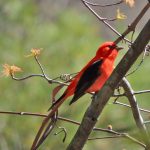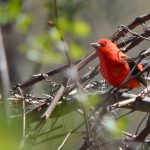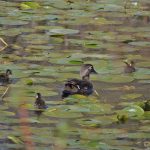May 18 2016. Townsend Ontario. A day of many interesting sightings. Two of us completed a census taking three and a half hours to do what normally takes two. It was full of surprises and pleasures and we ended up with a list of fifty-eight species. Stand-outs in my view, although my companion Barry may have other ideas, were hearing many Tennessee Warblers, finding a neck-breakingly high overhead Blackburnian Warbler, two Cooper’s Hawks patrolling the area on languid wingbeats reminiscent of a Short-eared Owl’s floppy flight style, a female Wood Duck with a brood of eleven day-old ducklings and finding ourselves in close proximity to a male Scarlet Tanager. I have gushed about Scarlet Tanagers often enough but sometimes bemoan the fact that I find them difficult to photograph. Today’s was enjoyed by a gathering crowd of walkers and my camera did well to get some quite good photos; here are a couple. (In a gallery visible only on the website, not if you’re reading this as an email.)
With our census done we went in pursuit of shorebirds at some distant sewage lagoons. Birders like sewage treatment areas, I won’t go into details; it’s one of our peculiarities.
It was quite good birding. The lagoons held large numbers of Dunlin, Least Sandpipers and Semi-palmated Plovers. It brought back memories of this time last year along the shores of New Jersey. We found one White-rumped Sandpiper which was interesting, more to Barry than to me I think. He scrutinized it at length, checked its field marks (streaky breast, wing length and slightly drooping bill) mulled over its purported body length in comparison to other sandpipers and gave it his conclusive stamp of approval.
Shorebirds can be excruciatingly difficult to sort out, I’m pretty comfortable with the ones we see most commonly; but a White-rumped Sandpiper is rare enough that I find that they just add to my confusion.
Back home I did a little more research and here’s where it gets really interesting: White-rumped Sandpipers migrate between the extreme southern end of South America, Patagonia in particular, to the extreme northern end of North America, the shores of the Arctic Ocean and Baffin Bay, to breed. A journey of 13,000 kilometers made in a few, long, non-stop flights which can last as long as 60 hours and cover up to 4,000 kilometers. All of this on reserves of body fat as fuel. Pause and think about all of that: a metabolism that converts some forty grams (around one ounce) of yellow, greasy fat into fuel enough to fly from Surinam to Ontario in one go; guided by an internal navigation system that relies on… what: Stars, Earth’s magnetic fields, the Sun? Who knows? Cool bird; Bird of the Day


